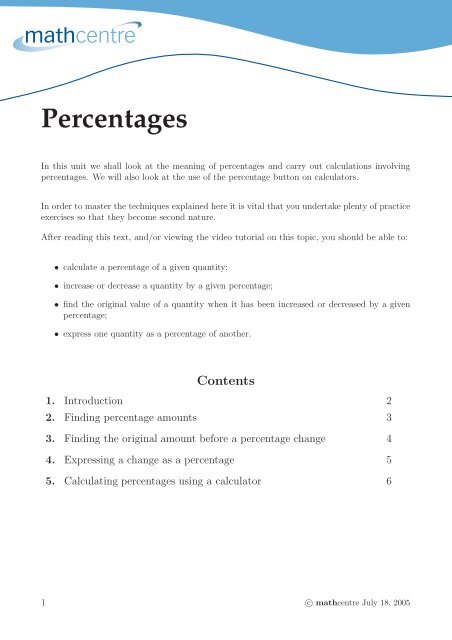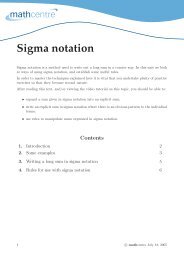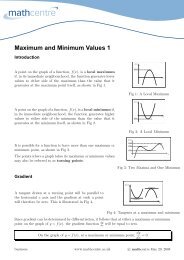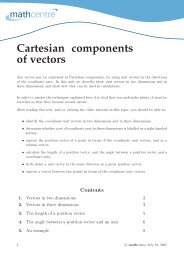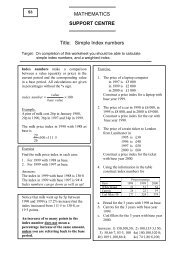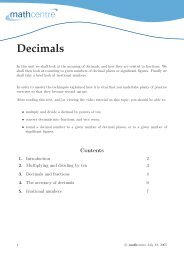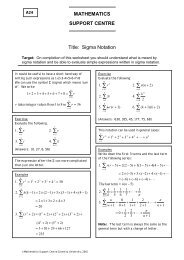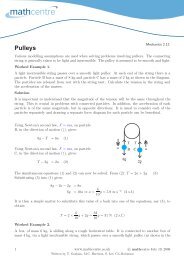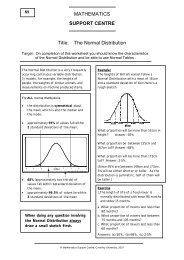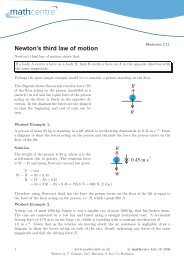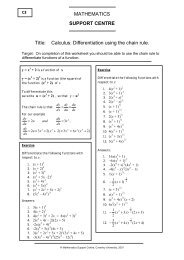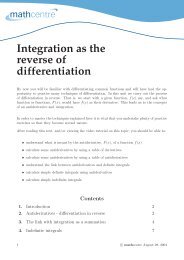Percentages
Percentages
Percentages
Create successful ePaper yourself
Turn your PDF publications into a flip-book with our unique Google optimized e-Paper software.
<strong>Percentages</strong><br />
In this unit we shall look at the meaning of percentages and carry out calculations involving<br />
percentages. We will also look at the use of the percentage button on calculators.<br />
In order to master the techniques explained here it is vital that you undertake plenty of practice<br />
exercises so that they become second nature.<br />
After reading this text, and/or viewing the video tutorial on this topic, you should be able to:<br />
• calculate a percentage of a given quantity;<br />
• increase or decrease a quantity by a given percentage;<br />
• find the original value of a quantity when it has been increased or decreased by a given<br />
percentage;<br />
• express one quantity as a percentage of another.<br />
Contents<br />
1. Introduction 2<br />
2. Finding percentage amounts 3<br />
3. Finding the original amount before a percentage change 4<br />
4. Expressing a change as a percentage 5<br />
5. Calculating percentages using a calculator 6<br />
1 c○ mathcentre July 18, 2005
1. Introduction<br />
The word ‘percentage’ is very familiar to us as it is used regularly in the media to describe<br />
anything from changes in the interest rate, to the number of people taking holidays abroad, to<br />
the success rate of the latest medical procedures or exam results. <strong>Percentages</strong> are a useful way<br />
of making comparisons, apart from being used to calculate the many taxes that we pay such as<br />
VAT, income tax, domestic fuel tax and insurance tax, to name but a few.<br />
So percentages are very much part of our lives. But what does percentage actually mean?<br />
Now ‘per cent’ means ‘out of 100’; and ‘out of’, in mathematical language, means ‘divide by’.<br />
So if you score 85% (using the symbol ‘%’ for percentage) on a test then, if there were a possible<br />
100 marks altogether, you would have achieved 85 marks. So<br />
85% = 85<br />
100 .<br />
Let us look at some other common percentage amounts, and their fraction and decimal equivalents.<br />
75% = 75<br />
100<br />
= 3 4<br />
= 0.75<br />
50% = 50<br />
100<br />
= 1 2<br />
= 0.5<br />
25% = 25<br />
100<br />
= 1 4<br />
= 0.25<br />
10% = 10 = 1<br />
100 10<br />
= 0.1<br />
5% = 5 = 1<br />
100 20<br />
= 0.05 .<br />
It is worth noting that 50% can be found be dividing by 2, and that 10% is easily found by<br />
dividing by 10.<br />
Now let us look at writing fractions as percentages. For example, say you get 18 marks out of<br />
20 in a test. What percentage is this?<br />
First, write the information as a fraction. You gained 18 out of 20 marks, so the fraction is 18<br />
Since a percentage requires a denominator of 100, we can turn 18 into a fraction out of 100 by<br />
20<br />
multiplying both numerator and denominator by 5:<br />
18<br />
20<br />
= 18 × 5<br />
20 × 5<br />
=<br />
90<br />
100<br />
= 90%.<br />
Since we are multiplying both the numerator and the denominator by 5, we are not changing<br />
the value of the fraction, merely finding an equivalent fraction.<br />
In that example it was easy to see that, in order to make the denominator 100, we needed to<br />
multiply 20 by 5. But if it is not easy to see this, such as with a score of, say, 53 out of 68, then<br />
we simply write the amount as a fraction and then multiply by 100<br />
100 :<br />
53<br />
68 × 100<br />
100<br />
= 53 ÷ 68 × 100% = 77.94%<br />
which is 78% to the nearest whole number. Although it is easier to use a calculator for this type<br />
of calculation, it is advisable not to use the % button at this stage. We shall look at using the<br />
percentage button on a calculator at the end of this unit.<br />
20 .<br />
c○ mathcentre July 18, 2005 2
Key Point<br />
Percentage means ‘out of 100’, which means ‘divide by 100’.<br />
To change a fraction to a percentage, divide the numerator by the denominator and multiply<br />
by 100%.<br />
Exercises 1<br />
(a) 7 out of every 10 people questioned who expressed a preference liked a certain brand of<br />
cereal. What is this as a percentage?<br />
(b) In a test you gained 24 marks out of 40. What percentage is this?<br />
(c) 30 out of 37 gambling sites on the Internet failed to recognise the debit card of a child. What<br />
is this as a percentage?<br />
2. Finding percentage amounts<br />
For many calculations, we need to find a certain percentage of a quantity. For example, it is<br />
common in some countries to leave a tip of 10% of the cost of your meal for the waiter. Say a<br />
meal costs £25.40:<br />
10% of £25.40 =<br />
10<br />
× £25.40 = £2.54 .<br />
100<br />
As mentioned before, an easy way to find 10% is simply to divide by 10. However the written<br />
method shown above is useful for more complicated calculations, such as the commission a<br />
salesman earns if he receives 2% of the value of orders he secures. In one month he secures<br />
£250,000 worth of orders. How much commission does he receive?<br />
2% of £250, 000 =<br />
2<br />
× £250, 000 = £5, 000 .<br />
100<br />
Many things that we buy have VAT added to the price, and to calculate the purchase price we<br />
have to pay we need to find 17 1 % and add it on to the price. This can be done in two ways.<br />
2<br />
For example, the cost of a computer is £634 plus VAT. Find the total cost.<br />
VAT = 17 1 % of £634<br />
2<br />
= 17.5<br />
100 × £634<br />
= £110.95<br />
so total cost = £634 + £110.95<br />
= £744.95 .<br />
3 c○ mathcentre July 18, 2005
Or, instead of thinking of the total cost as 100% of the price plus 17 1 % of the price, we can<br />
2<br />
think of it as 117 1 % of the price, so that<br />
2<br />
117 1 117.5<br />
% of £634 = × £634 = £744.95 .<br />
2<br />
100<br />
Although 17 1 % seems an awkward percentage to calculate, there is an easy method you can use<br />
2<br />
so that you do not need a calculator. Let us look at the same example again.<br />
£634<br />
10% is £63.40 (divide by 10)<br />
5% is £31.70 (half of 10%)<br />
2 1 % is £15.85 (half of 5%)<br />
2<br />
so 17 1 % is £110.95 (add the above).<br />
2<br />
In a similar way to a percentage increase, there is a percentage decrease. For example, shops<br />
often offer discounts on certain goods. A pair of trainers normally costs £75, but they are<br />
offered for 10% off in the sale. Find the amount you will pay.<br />
Now 10% of £75 is £7.50, so the sale price is £75 − £7.50 = £67.50.<br />
What you are paying is the 100% of the cost, minus 10% of the cost, so in effect you are paying<br />
90% of the cost. So we could calculate this directly by finding 90% of the cost.<br />
90% of £75 =<br />
90<br />
× £75 = £67.50 .<br />
100<br />
3. Finding the original amount before a percentage change<br />
Let us look at an example where the price includes VAT, and we need the price excluding VAT.<br />
Example<br />
The cost of a computer is £699 including VAT. Calculate the cost before VAT.<br />
Solution<br />
Now a common mistake here is to take 17 1 % of the cost including VAT, and then subtract. But<br />
2<br />
this is wrong, because the VAT is not 17 1 % of the cost including the VAT, which is what we<br />
2<br />
have been given. Instead, the VAT is 17 1 % of the cost before the VAT, and this is what we are<br />
2<br />
trying to find. So we have to use a different method.<br />
Now we have been told that £699 represents the cost including VAT, so that must equal the<br />
cost before VAT, plus the VAT itself, which is 17 1 % of the cost before VAT. So the total must<br />
2<br />
be 100% + 17 1% = 2 1171% of the cost before VAT. Thus, to find 1% we divide by 2 1171. So 2<br />
117 1 % of the price excluding VAT = £699,<br />
2<br />
1% of the price excluding VAT = £699<br />
117.5 .<br />
To find the cost before VAT we want 100%, so now we need to multiply by 100. Then<br />
the price excluding VAT = £699<br />
117.5 × 100<br />
= £594.89 .<br />
c○ mathcentre July 18, 2005 4
Let us look at another situation where we need to find an original amount before a percentage<br />
increase has taken place.<br />
Example<br />
An insurance company charges a customer £320 for his car insurance. The price includes<br />
government insurance premium tax at 5%. What is the cost before tax was added?<br />
Solution<br />
Here, the £320 represents 105% of the cost, so to calculate the original cost, 100%, we need to<br />
calculate<br />
£320<br />
× 100 = £304.76 .<br />
105<br />
Here is one more similar calculation, but this time there has been a reduction in cost.<br />
Example<br />
A shop has reduced the cost of a coat by 15% in a sale, so that the sale price is £127.50. What<br />
was the original cost of the coat?<br />
Solution<br />
In this case, £127.50 represents 85% (that is, 100% − 15%) of the original price. So if we write<br />
this as a fraction, we divide by 85 to find 1% and then multiply by 100 to find the original price.<br />
£127.50<br />
85<br />
× 100 = £150 .<br />
Key Point<br />
If you are given a percentage change and the final amount, write the final amount as 100% plus<br />
(or minus) the percentage change, multiplied by the original amount.<br />
4. Expressing a change as a percentage<br />
We might wish to calculate the percentage by which something has increased or decreased. To<br />
do this we use the rule<br />
actual increase or decrease<br />
× 100%.<br />
original cost<br />
So you write the amount of change as a fraction of the original amount, and then turn it into a<br />
percentage.<br />
Example<br />
Four years ago, a couple paid £180,000 for their house. It is now valued at £350,000. Calculate<br />
the percentage increase in the value of the house.<br />
5 c○ mathcentre July 18, 2005
Solution<br />
actual increase<br />
Percentage increase = × 100%<br />
original cost<br />
£350, 000 − £180, 000<br />
= × 100%<br />
£180, 000<br />
£170, 000<br />
=<br />
£180, 000 × 100%<br />
= 94% to the nearest 1% .<br />
Let us look at an example where the change has been a decrease.<br />
Example<br />
A car cost £12,000. After 3 years it is worth £8,000. What is the percentage decrease?<br />
Solution<br />
actual decrease<br />
Percentage decrease = × 100%<br />
original cost<br />
£12, 000 − £8, 000<br />
= × 100%<br />
£12, 000<br />
£4, 000<br />
=<br />
£12, 000 × 100%<br />
= 33% to the nearest 1% .<br />
Key Point<br />
To write an increase or decrease as a percentage, use the formula<br />
actual increase or decrease<br />
original cost<br />
× 100%.<br />
5. Calculating percentages using a calculator<br />
Here is a warning about using the percentage button on a calculator: the result depends on<br />
when you press the % button in your calculation. Sometimes it has no effect, sometimes it<br />
seems to divide by 100, and at other times it multiplies by 100. Here are some examples<br />
• Pressing 48 ÷ 400% gives an answer of 12. Now 48 ÷ 400 = 0.12, so pressing the % button<br />
has had the effect of multiplying by 100. This has found 48 as a percentage of 400.<br />
• Pressing 1 ÷ 2 × 300% gives the answer 1.5. Now 1 ÷ 2 × 300 = 150, so pressing the %<br />
button here has divided by 100. This has found 300% of a half.<br />
c○ mathcentre July 18, 2005 6
• Pressing 400 × 50% gives an answer of 200. Now 400 × 50 = 20, 000, so pressing % here<br />
has divided by 100. This has found 50% of 400.<br />
• Pressing 50% × 400 results in 400 on the display, requiring = to be pressed to display an<br />
answer of 20,000. So pressing the % button here has had no effect.<br />
Key Point<br />
We recommended that you use the % button on a calculator only when you understand what<br />
affect it is having on your calculation.<br />
Exercises 2<br />
(a) What is the amount of VAT (at a rate of 17 1 %) which must be paid on an imported computer<br />
2<br />
game costing £16.00?<br />
(b) A visitor to this country buys a souvenir costing £27.50 including VAT at 17 1 %. How much<br />
2<br />
VAT can be reclaimed?<br />
(c) At the end of 1999 you bought shares in a company for £100. During 2000 the shares<br />
increased in value by 10%. During 2001 the shares decreased in value by 10%. How much were<br />
the shares worth at the end of 2001?<br />
(Give your answers to the nearest penny.)<br />
Answers<br />
1.<br />
2.<br />
(a) 70% (b) 60% (c) 81%<br />
(a) £2.80 (b) £4.10 (c) £99.00 .<br />
7 c○ mathcentre July 18, 2005


